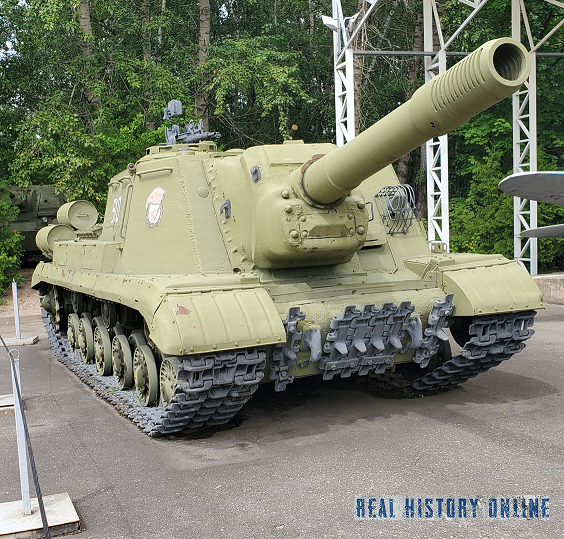
ISU-152 BEAST KILLER AT MOSCOW MUSEUM
ISU-152 – WW2 TIGER, PANTHER and BIG CAT TANK KILLER
SU-152 successfully combined three main combat roles, as a heavy assault gun, the installation, however, was also used as a tank destroyer, and in rare cases it could also be used as a self-propelled howitzer.
Developed by the design bureau of Pilot Plant No. 100 in June-October 1943 and adopted by the Workers ‘and Peasants’ Red Army (RKKA) on November 6 of the same year. At the same time, its serial production began at the Chelyabinsk Kirov Plant (ChKZ), which continued until 1946. In the spring of 1945, the Leningrad Kirov Plant joined the production(LKZ), who assembled a number of cars until 1947. Externally, the Leningrad self-propelled guns were distinguished by a fixed gun armor – it did not have characteristic ribs along the edges, the sidewalls were more puffy. On some machines, it was bolted from the outside, and not from the inside. ISU-152s were widely used at the final stage of the Great Patriotic War, in almost all aspects of the use of self-propelled artillery. In addition to the Red Army, the ISU-152 was in service with the armies of Poland and Czechoslovakia, single captured vehicles were used by the Wehrmacht and the army of Finland. Only one photograph is known (dated 1944) of an ISU-152 used by the Finnish Army.
ISU-152 (Object 241) – Soviet heavy self-propelled artillery (ACS) during the Second World War. In the name of the vehicle, the letter “I”, in addition to the standard Soviet designation “SU” – self-propelled unit, means “based on the IS tank”. Self- propelled guns of the same caliber called SU-152 were produced at a different tank base. Index 152 means the caliber of the main armament of the vehicle.
In the post-war period, ISU-152s underwent modernization and were in service with the Soviet Army for a long time. They were also supplied to equip the Egyptian armed forces. Self-propelled guns transferred to Egypt took part in the Arab-Israeli armed conflicts in the Middle East. Participated in the Six Day War in the form of fixed gun emplacements dug into the sand along the fenders. Non-modernized versions were delivered to Egypt, however, they were equipped with a night vision system with an IR searchlight mounted in pairs with a headlight in a protective basket to the left of the gun. Since the mid 1970s, ISU-152 were removed from service with the Soviet Army and replaced with more modern self-propelled guns; a number of machines that survived from cutting into metal now serve as monuments and exhibits in museums around the world.
The slang name for the ISU-152 is “St. John’s wort”. In the Wehrmacht, she was called “Dosenöffner” (from German - ”can opener”).
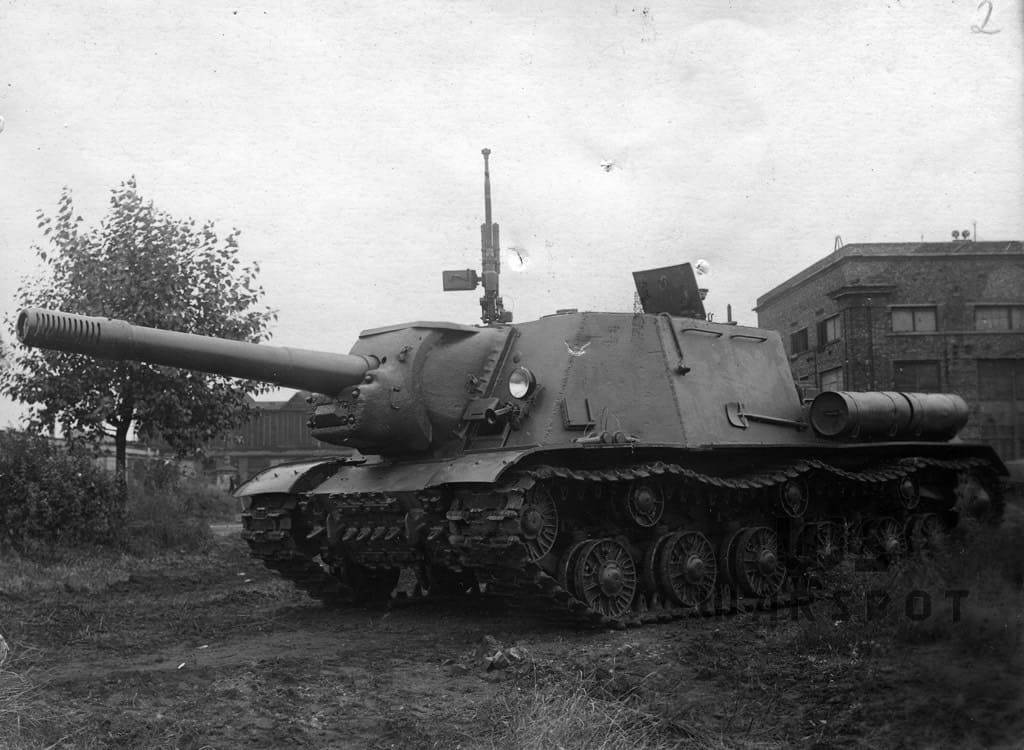
ISU 152 Howitzer
ISU-152 Combat Evaluation
In general, the ISU-152 was a fairly successful example of a universal heavy self-propelled artillery mount. The features noted above in the Combat use section and the long service life of the vehicle in the Soviet army serve as additional confirmation of this.
The armor of the ISU-152 was quite adequate for the later stages of World War II. Frontal 90-mm armor plates, inclined at an angle of 30 °, confidently protected the car from the most common German 75-mm Pak 40 anti-tank gun at distances over 800 m. The ISU-152 was easy to repair ; often self-propelled guns knocked out by the enemy returned to service after a couple of days of repair in the field. After the elimination of “childhood diseases”, the ISU-152 machine has established itself as a very reliable and unpretentious self-propelled gun; it was easily mastered by untrained crews.
However, in addition to the advantages, the ISU-152 also had disadvantages. The largest of them was a small portable ammunition load of 21 shots.. Moreover, loading new ammunition was a laborious operation, sometimes taking more than 40 minutes. This was a consequence of the large mass of shells, as a result, the loader required great physical strength and endurance. The ST-10 telescopic sight was calibrated for firing at a distance of up to 900 m, while the gun allowed direct fire at a distance of more than 3.5 km. Therefore, with accurate shooting at a distance of over 900 m, the gunner was forced to use a less convenient panoramic sight. Another way to solve this problem was to concentrate the fire of several self-propelled guns at the desired point. Insufficient accuracy was compensated by firepower. The hit of a high-explosive fragmentation projectile in the close vicinity of a heavily armored target often disabled it even without breaking through the armor (the gun was damaged by the blast wave and fragments, undercarriage, aiming devices of the target). Shooting with powerful high-explosive fragmentation shells at armored targets was quite common, since 13 out of 20 rounds in the ammunition load were precisely high-explosive fragmentation. The remaining 7 were concrete or armor-piercing.
The compact layout made it possible to reduce the overall size of the vehicle, which had a positive effect on its visibility on the battlefield. However, the same layout forced the placement of fuel tanks inside the fighting compartment. In the event of their penetration, the crew had a great risk of being burned alive. However, this danger was somewhat reduced by the worse flammability of diesel fuel compared to gasoline and the presence of a tetrachlorine fire extinguisher. In front-line reports, it was often noted that ignited vehicles based on the heavy IS tank (including the ISU-152) were easily extinguished.
It is very difficult to compare the ISU-152 with other self-propelled guns from various countries of that period due to the lack of analogues in terms of the combination of tactical use, the mass of the vehicle and its weapons. Long-barreled guns of 150-155 mm caliber were equipped only with lightly armored self-propelled howitzers Hummel (Germany) and Gun Motor Carriage M12 (USA) based on medium tanks, which were neither anti-tank self-propelled guns nor assault guns. In the weight category of 45-50 tons, there is only the German Jagdpanther tank destroyer, which was not yet an assault gun at the same time. German assault guns, also performing anti-tank functions, StuG III and StuG IV were significantly lighter than the ISU-152 in armament and mass, and also weaker armored. The assault tank (actually a self-propelled gun) StuPz IV “Brummbär” was also lighter in weight and equipped with a short-barreled 150-mm gun, its anti-tank capabilities were significantly limited. To some extent, the German Jagdtigr can be considered an analogue of the ISU-152, which also had a very powerful 128 mm cannon and extremely strong armor. On the other hand, the German self-propelled guns still had a pronounced anti-tank focus; in addition, in terms of mass, it exceeded the ISU-152 by 1.7 times. The armored vehicles of the Second World War of the United States and Great Britain did not have serial models of heavy self-propelled artillery installations at all.
In addition to World War II, the ISU-152 was used in the suppression of the Hungarian uprising of 1956, where they once again confirmed their tremendous destructive power. Particularly effective was the use of the ISU-152 as a powerful anti-sniper rifle” to destroy rebel snipers hiding in residential buildings in Budapest, who inflicted significant damage on Soviet troops. Sometimes only the presence of self-propelled guns nearby was enough for the inhabitants of the house, in fear for their lives and property, to expel snipers or bottle throwers who had settled there.
In the Arab-Israeli wars, ISU-152s were used mainly as stationary firing points along the banks of the Suez Canal, and showed little in the hands of the Egyptian troops. A number of these vehicles were captured by the Israeli army.
Self-propelled guns were used to clear debris and shoot concrete buildings during the aftermath of the accident at the Chernobyl nuclear power plant.
ISU-152 as a heavy assault gun
The main use of the ISU-152 was fire support for advancing tanks and infantry. The 152-mm howitzer-gun ML-20S had a powerful OF-540 high-explosive fragmentation projectile weighing 43.56 kg, equipped with 6 kg of TNT (trinitrotoluene, TNT). These shells were very effective against both uncovered infantry (with the fuse set to fragmentation) and against fortifications such as pillboxes and trenches (with the fuse set to high explosive). One hit of such a projectile in an ordinary medium-sized city house was enough to destroy all living things inside.
ISU-152s were especially in demand in urban combat, such as the assaults on Berlin, Budapest, or Königsberg. The self-propelled gun’s good armor allowed it to advance to a direct fire range to destroy enemy firing points, while for conventional towed artillery it was deadly due to enemy machine-gun and aimed sniper fire.
To reduce losses from the fire of “faustniks” (German soldiers armed with “panzershreks” or “faustpatrons”), in urban battles, ISU-152 used one or two self-propelled guns along with an infantry squad (assault group) to protect them. Usually the assault group included a sniper (or at least just a well-aimed shooter), submachine gunners and sometimes a backpack flamethrower. The DShK large-caliber machine gun on the ISU-152 was an effective weapon for destroying Faustniks hiding on the upper floors of buildings, behind rubble and barricades. Skillful interaction between the crews of self-propelled guns and attached infantry fighters made it possible to achieve the set goals with the least losses; otherwise, the attacking vehicles could be very easily destroyed by the Faustniks.
The well-known tanker and author of memoirs D. F. Loza characterizes the ISU-152 in this role in this way:
Shortly before this, the Nazis began shelling “Emcha” standing under the arches, from an anti-tank gun, which was dragged at night to the top floor of one of the houses, north of the Town Hall. Its fire damaged the tracks of two tanks. It was necessary to take urgent measures, otherwise most of the combat vehicles east of the City Hall, the University and Parliament could be damaged by the fire of this weapon, and if we change their positions, then we will lose several blocks. He called the commander of the ISU-152 battery and ordered him to immediately suppress the enemy firing point. The self-propelled gun, slapping on the asphalt with wide caterpillars, took up a position on one of the streets overlooking the southeast side of the square. The same curiosity that killed more virgins than love dragged us out into the street to see how the self-propelled gunners would smash the German artillerymen with their cannon to pieces with one shell. Tankers and paratroopers settled down near the “St. Why did you allow these “brides”? They had to pay a high price for them.
Viennese streets, running in different directions from the central square, are not wide. Beautiful houses with Venetian windows rise on both sides. A shot from a large-caliber self-propelled gun rang out. The air shook sharply. One and a half floors of the house, together with an enemy anti-tank gun and its servants, collapsed to the ground. And in our location, from a powerful air wave of a shot, thick glasses burst with a crack in the houses located next to the self-propelled unit. Their heavy fragments rained down on the heads of the “spectators”, as a result, the arms and backs of ten people were injured, and two had broken collarbones. Fortunately, the tankers were in helmets, the paratroopers were in helmets, and their heads remained intact!
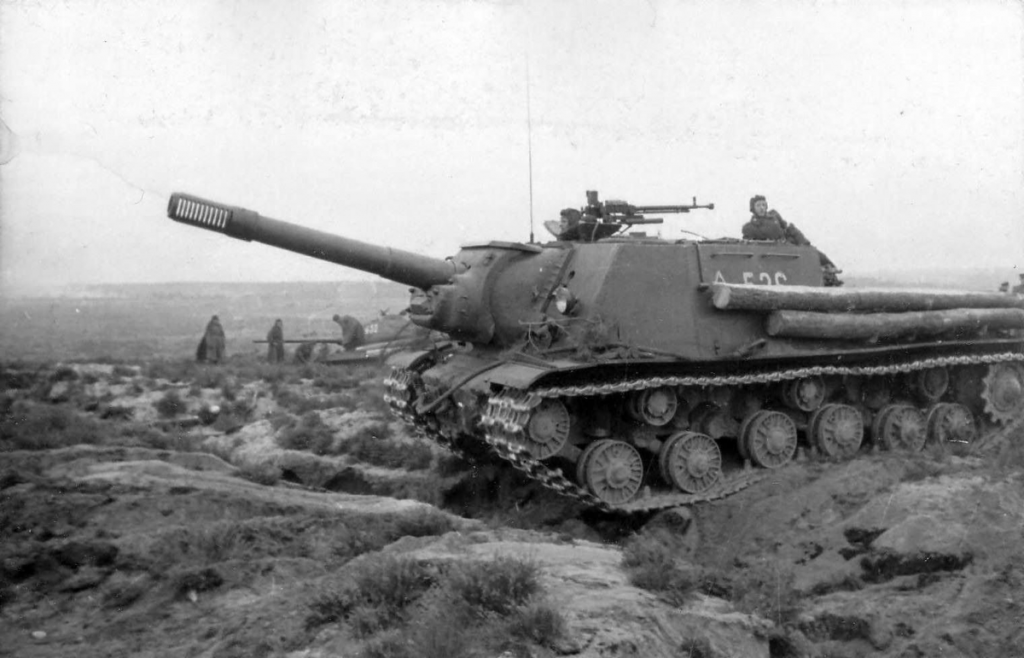
ISU 152 Howitzer
ISU-152 as a Tank Destroyer
ISU-152 could also successfully act as a tank destroyer, although it was significantly inferior to specialized tank destroyers, which were armed with anti-tank guns. In this capacity, she inherited the nickname “Deerslayer” from her predecessor, the SU-152. An armor-piercing projectile BR-540 weighing 48.9 kg with an initial speed of 600 m / s was intended to destroy armored targets, hitting the BR-540 in any of the projections of any serial Wehrmacht tank was very destructive, the chance to survive after it was negligible. In some cases, only the frontal armor of Ferdinand anti-tank self-propelled guns could withstand the hit of such a projectile.
It is appropriate to note that the ISU-152 was not a true tank destroyer; she had a low rate of fire compared to “real” tank destroyers, such as the German “Jagdpanther” or the domestic SU-100 (their rate of fire reached 5-8 rounds per minute, albeit for a short period of time). On the other hand, careful camouflage, quick change of firing positions and the use of ISU-152 in groups of 4-5 vehicles partially compensated for the lack of rate of fire. In addition, in 1944-1945, a sufficient number of specialized tank destroyers of the SU-85, SU-100 and ISU-122 types already appeared in the Red Army., therefore, combat clashes between the ISU-152 and enemy armored vehicles were no longer as frequent as with the SU-152 in 1943, when the latter was the only powerful Soviet anti-tank weapon. They tried to use the ISU-152 more as an assault gun, since its firepower was significantly superior to any other Soviet tanks and self-propelled guns.
Another quote from the memoirs of D. F. Loza about ISU-152 Combat:
The current situation should be immediately reversed, and, thank God, I had an effective tool in my hands – self-propelled guns. With the battery commander, Senior Lieutenant Yakov Petrukhin, we discussed the action plan in detail. We agreed that the installations, using the range and firepower of their 152-mm guns, would first of all knock out the advancing Panthers, and then finish off the previously knocked out ones. I paid special attention of the battery commander to the secrecy of the self-propelled guns entering the firing positions, which the Sherman crews would cover, firing mainly to distract the German tankers.
Yakov Petrukhin chose two very convenient places for firing, where stone fences covered the hulls of vehicles from enemy armor-piercing shells.
From our side, the fire intensified along the entire eastern line. “Emchists” tried not to allow the Nazis to enter the central square, locking them in the streets adjacent to it, and also to cover the exit of self-propelled guns to firing positions.
How slowly time passes when in a fight with the enemy you wait for the decisive moment that can turn the tide of the battle. Here it is, the long-awaited moment! Two thunderous shots hit the eardrums, shattering the glass in the windows of nearby houses.
The “Second Viennese spectacle” turned out to be no less impressive… On one of the “Panthers”, which had almost crawled out onto the square, the tower was demolished from the impact of a large-caliber concrete-piercing projectile. The second heavy tank burst into flames with a huge fire. And the ISU-152 immediately left their positions. The German tanks hastily began to back away, leaving the infantry without support, which immediately scattered through the yards and lanes.
The OF-540 high-explosive fragmentation projectile could also be used against tanks with good results. D. F. Loza briefly characterizes this possibility as follows: “But there was no huge roar. Of course, maybe if such a monster as the ISU-152 hits, you will hear it! And he will demolish the tower together with their heads”.
ISU-152 as a self-propelled howitzer
ISU-152s are very infrequent, but were used as self-propelled howitzers for indirect fire. The Red Army did not have specialized vehicles for this purpose, like the German Hummel, the American Howitzer Motor Carriage M7, or the English Sexton. The tank and mechanized units of the Red Army were well equipped with towed artillery, but towed guns were vulnerable on the march, and they could not support tanks and motorized infantry as they quickly advanced into enemy defenses. In this role, the ISU-152 was also used for artillery preparation. The maximum firing distance of the ISU-152 was about 13 km, despite the limited 20 ° gun elevation angle. However, the ability to fire from closed positions was severely limited by the low loading speed of the projectiles. In addition, unlike the towed version of the ML-20 gun, which had an elevation angle of 65 °, the ISU-152 could not fire along high-steep trajectories. This significantly reduced the scope of this machine as a self-propelled howitzer.
Shooting ISU-152 from closed positions is also a subject of controversy in military-themed forums. According to the documents, two facts of such use of self-propelled guns were reliably established, there is also a photograph of an ISU-152 firing from closed positions with ammunition laid next to a self-propelled gun. Some more evidence was found in memoir sources. It is likely that in addition to these cases, this was practiced more than once, since front-line reports and photographic documents contain only part of the information about the combat use of vehicles. However, their small number indicates that the use of the ISU-152 as a self-propelled howitzer in the Great Patriotic War was a rare occurrence.
However, in the post-war period, aspects of the combat use of the ISU-152 began to shift from an assault gun towards a self-propelled howitzer. The new tanks of the T-55 and T-62 types, which became widespread, had higher tactical and operational mobility, so that heavy slow-moving ISUs could successfully accompany them in the offensive. The armor of the ISU-152 was no longer sufficient against new anti-tank weapons, and the new 100-mm and 115-mm guns of the T-55 and T-62 tanks had a good high-explosive fragmentation projectile against enemy field fortifications. In the conditions of stagnation in the development of Soviet self-propelled artillery, thanks to the rapid development of missile weapons, the ISU-152 was preserved as assault guns for urban battles and began to be used as self-propelled howitzers, where the requirements for security and operational mobility were not so critical.
ISU Unit Organization
ISU-152, together with SU-152 and ISU-122, were used in separate heavy self-propelled artillery regiments. From May 1943 to 1945, 53 regiments of such units were formed.
Each had 21 self-propelled guns consisting of 4 batteries of 5 vehicles each, plus the self-propelled guns of the regiment commander. The regiment commander usually had the rank of colonel or lieutenant colonel, battery commanders – the rank of captain or senior lieutenant. Self-propelled gun commanders and driver mechanics were generally lieutenants or second lieutenants. The rest of the crew, according to the staff list, were sergeants or privates. Usually had several unarmored support and support vehicles – trucks, jeeps or motorcycles.
Starting in December 1944, Guards heavy self-propelled artillery brigades began to form to provide heavy fire support for tank armies. Their organization was borrowed from tank brigades, the number of vehicles in both cases was the same – 65 self-propelled guns or tanks, respectively.
For their valor during the liberation of Belarusian cities, 8 units were awarded their honorary titles, and three more regiments were awarded the Order of the Red Banner of Battle.
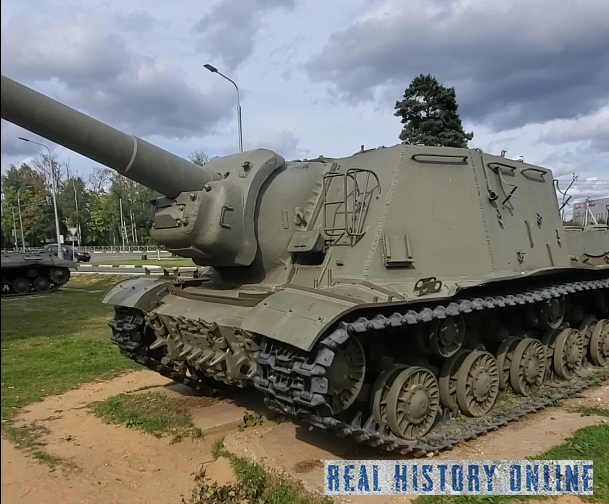
ISU-152 BEAST KILLER
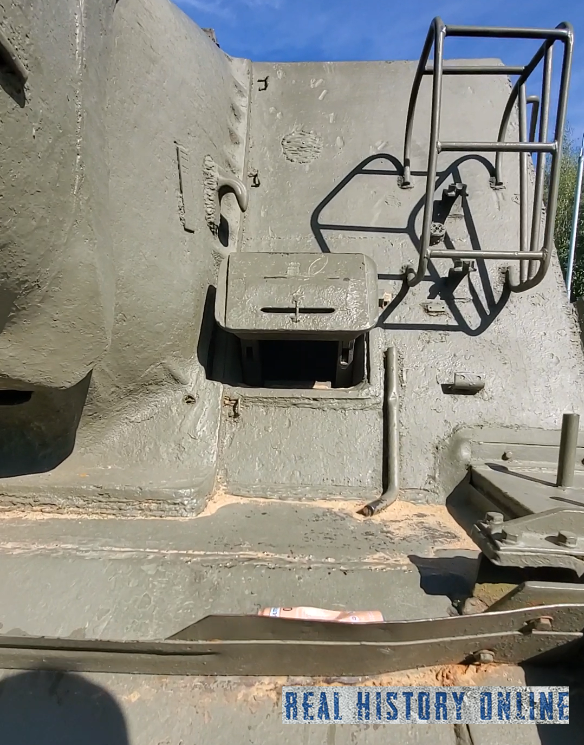
ISU 152 Howitzer
ISU-152 – DESIGN AND HISTORY
Work on the creation of the ISU-152 self-propelled guns began in June 1943 at the design bureau of Experimental Plant No. 100 in Chelyabinsk in connection with the final decision to replace the KV-1 heavy tank in production with a new advanced IS-1 tank. However, on the basis of the KV tank, the heavy assault gun SU-152 was produced, the need for which the army was extremely high (in contrast to the need for heavy KV tanks). The excellent combat qualities of the SU-152 served as the basis for the creation of its analogue based on the IS-1 tank.
The development of the ISU-152 was led by Joseph Yakovlevich Kotin, the main developer of the entire Soviet line of heavy tanks. The chief designer of the ISU-152 was G. N. Moskvin. In the early stages, the project for a new self-propelled guns was designated as IS-152. In October 1943, the first prototype, Object 241, was built. He successfully passed the factory and state tests; On November 6, 1943, by decree of the State Defense Committee No. GOKO-4504ss, the new self-propelled guns were adopted by the Red Army under the final name ISU-152. Mass production began the same month.ISU-152 at ChKZ. In December 1943, the SU-152 and ISU-152 were still produced jointly at ChKZ, and from the following month, the ISU-152 completely replaced its predecessor, the SU-152, on assembly lines.
Due to the heavy workload of ChKZ with the release of heavy tanks IS-2, armored hulls for self-propelled guns ISU were supplied by the Ural Heavy Machine Building Plant (UZTM).
During the production process, minor changes were made to the design of the ISU-152, aimed at improving the combat and operational qualities and reducing the cost of the vehicle. In the second half of 1944, a new welded nose of the hull made of rolled armor plates was introduced instead of one solid piece, the thickness of the armored mask of the gun was increased from 60 to 100 mm. Also, a 12.7-mm anti-aircraft heavy machine gun DShK began to be installed on the self-propelled guns and the capacity of internal and external fuel tanks was increased. The 10P radio was replaced by an improved version of the 10RK.
The planned replacement of the KV-1 heavy tank with the promising IS-85 breakthrough tank also required the transfer of the SU-152 to a promising base. But this work on improving the ACS was not limited. Even before the combat debut of the SU-152, it had a number of serious shortcomings. In this regard, on May 25, 1943, by order of the plant number 100, the design group of self-propelled artillery began to modernize the machine. The group was headed by G. N. Moskvin and seconded to it N. V. Kurin, who has extensive experience in creating self-propelled artillery installations. Together with the customer, extended tactical and technical requirements were developed for a modernized sample of heavy self-propelled guns, which at that time was designated in the documents as SU-152-M. According to primary sources, they included the following:
The development of the SU-152-M heavy self-propelled gun is being carried out to replace the KV-14 self-propelled gun.
ISU-152 DESIGN REQUIREMENTS
1) for self-propelled use the chassis and logistics of the tank “Object 237”;
2) Keep the main armament in the form of a 152-mm self-propelled gun ML-20S mod. 1942, which has the internal ballistics of a howitzer-cannon of the specified caliber mod. 37;
3) Necessary to supplement the cannon armament of a heavy self-propelled gun with a defensive circular firing machine gun of 7.62 mm caliber or an anti-aircraft machine gun of 12.7 mm caliber;
4) Increase the thickness of the frontal hull armor to 90-100 mm;
5) Increase visibility by using several viewing devices of the Mk-IV type on a swivel base;
6) Improve the ventilation of the fighting compartment by introducing an additional fan or provide for purging the gun barrel after firing…
The completion of the project was planned by July 1, 1943, but the group coped with the task ahead of schedule, at the end of July the construction of a prototype was started, called the IS-152.
However, in the future, ambiguity sets in – the new tanks IS-85, KV-85 and self-propelled guns IS-152 were shown in the Kremlin to the country’s leadership headed by I. V. Stalin, however, there are no memoirs of participants in the events and available archival documents: the exact date of this review and the exact list of those present. The day is called July 31, 1943, but according to ChKZ documents, then the KV-85 and IS-85 tanks were being tested. Historian M. N. Svirin suggests holding the show on August 31, and a group of authors of numerous publications on armored topics under the leadership of Colonel I. G. Zheltov – on September 8. It is also not clear which ACS was shown to the management. It is assumed that it was an experimental self-propelled gun IS-152, but there is a photograph showing I.V. Stalin in the Kremlin on a self-propelled gun, outwardly identical to the SU-152. It is possible that the management was shown a modernized sample of the SU-152, on which the improvements intended for implementation on the IS-152 were tested.
One way or another, but by the above-mentioned GKO decree No. 4043ss of September 4, 1943, it was the IS-152 self-propelled guns that were put into service along with the KV-85 and IS-85, but according to the ChKZ documents, it turned out to be much more expensive than the serial SU-152. During September – October 1943, the design of the IS-152 self-propelled guns was improved, a second prototype was built: Object 241 based on the IS tank, which turned out to be comparable in cost to the serial SU-152. It was accepted for mass production on November 6, 1943 as the ISU-152.
Comparative characteristics of self-propelled guns: SU-152 and ISU-152
Comparison table
| ACS: | SU-152 | ISU-152 |
| Base tank: | KV-1s | IS-1, IS-2 |
| Weight, t | 45÷45.5 | 45.5÷46.0 |
| Case length, mm | 6750 | 6770 |
| Length with gun, mm | 8950 | 9050÷9180 |
| Width, mm | 3250 | 3070 |
| Height, mm | 2450 | 2480 |
| Clearance, mm | 440 | 460÷470 |
| Booking elements: | thickness, mm/slope, degrees | thickness, mm/slope, degrees |
| Forehead of the hull (top) | 60/70° | 90/60° |
| Forehead of the body (bottom) | 60/30 | 90/30° |
| Hull board (top) | 60/0° | 75/15° |
| Hull board (bottom) | 60/0° | 90/0° |
| Hull stern (top) | 60/radius | 60/49° |
| Hull feed (bottom) | 60/0° | 60/41° |
| Bottom, front (rear) | 30(20) | 20 |
| Hull roof | thirty | thirty |
| Forehead felling | 75/30° | 90/30° |
| Chine felling | 60/25° | 75/15° |
| cabin board | 60/25° | 75/15°; (60/15°) |
| felling feed | 60/10° | 60/0° |
| Cabin roof | 20 | thirty |
| Gun mask | 60-65 | 100; (120) |
| Gun ammunition, pieces | 20 | 21 |
| HV angles | −5° ÷ +18° | −3°÷ +20° |
| GN angles | 12° | 10° |
| Sights: | telescopic ST-10, + Hertz panorama | telescopic ST-10, + Hertz panorama |
| Engine brand | Diesel engine: V-2K | Diesel engine: V-2-IS |
| Maximum engine power, h.p. | 600 | 520 |
| Rated engine power, h.p. | 550 | .. |
| Engine power operational, h.p. | 500 | .. |
| Specific power, hp/t | 13.2 | 11.3÷11.4 |
| Specific ground pressure, kg/cm² | 0.81÷0.85 | 0.81÷0.82 |
| Highway speed maximum, km/h | 43 | 35 |
| Cross-country speed, km/h | thirty | 10÷15 |
| Range on the highway, km | 165÷330 | 220 |
| Power reserve over rough terrain, km | 165 | 140; (145÷200) |
| Climbability | 36° | 36° |
| Passable wall, m | 1.2 | 1.9 |
| Crossable ditch, m | 2.5 | 2.5 |
| Crossable ford, m | 0.9 m | 1.3÷1.5 |
Mass production
On November 6, 1943, by a decree of the State Defense Committee, the new self-propelled guns were adopted by the Red Army under the final name ISU-152. In the same month, serial production of the ISU-152 began at the Chelyabinsk Kirov Plant (ChKZ). In December 1943, the SU-152 and ISU-152 were still produced jointly at ChKZ, and from the following month, the ISU-152 completely replaced its predecessor, the SU-152, on assembly lines.
During the production process, minor changes were made to the design of the ISU-152, aimed at improving the combat and operational qualities and reducing the cost of the vehicle.
Due to the heavy workload of ChKZ with the production of heavy tanks IS-2, ISU armored hulls for self-propelled guns were supplied by the Ural Heavy Engineering Plant(UZTM).
Due to the lack of ML-20S howitzer gun barrels, since April 1944, the serial production of the ISU-122 self-propelled guns began, which differed from the ISU-152 only in the installed artillery system (respectively, the sight, ammunition load and trends in combat use) – instead of the ML-20S in the armored hull 121.92-mm A-19C guns were mounted, which at that time were in abundance in the arms depots.
In the second half of 1944, a new welded nose of the hull made of rolled armor plates was introduced instead of one solid piece, the thickness of the armored mask of the gun was increased from 60 to 100 mm. Also on the self-propelled guns began to install a 12.7-mm anti-aircraft heavy machine gun DShKand increased the capacity of internal and external fuel tanks. The 10P radio was replaced by an improved version of the 10RK.
At the end of 1944, a 12.7-mm anti-aircraft heavy machine gun DShK began to be installed on the self-propelled guns. Since January 1945, all installations have already been produced with these machine guns.
Design Description and Features
The ISU-152 had the same layout as all other serial Soviet self-propelled guns of the time (with the exception of the SU-76 ). The fully armored hull was divided into two parts. The crew, gun and ammunition were placed in front in the armored cabin, which combined the fighting compartment and the control compartment. The engine and transmission were installed in the rear of the car.
Armored hull and wheelhouse
ISU-152 crew : 1 – driver; 2 – commander; 3 – gunner; 4 – castle; 5 – loader.
The armored body of the self-propelled unit was welded from rolled armor plates with a thickness of 90, 75, 60, 30 and 20 mm. On the machines of the first series, the frontal part of the hull was an armor casting; subsequently, as more resistant rolled armor was available, the design of the frontal part of the hull was replaced with a welded one. Armor protection is differentiated, anti-ballistic. Armored cutting plates were installed at rational angles of inclination. Compared to the previous model of self-propelled guns of the same class and purpose – SU-152, – the ISU-152 armored hull was distinguished by a slightly higher height (since it did not have such a deep landing as the KV series vehicles) and a larger volume of armored cabin due to a decrease in the angles of inclination of the zygomatic and side armor plates. The slight decrease in protection associated with this was compensated by the thickening of the armor of these parts of the cabin. Compared to the SU-152, a larger felling volume provided better working conditions for the crew. The main armament – a 152.4-mm ML-20 C howitzer-gun – was mounted in a frame-type installation to the right of the vehicle’s centerline. The recoil devices of the gun were protected by a fixed cast armor casing and a movable cast spherical armored mask, which also served as a balancing element.
Three crew members were located to the left of the gun: in front of the driver, then the gunner, and behind the loader. The commander of the vehicle and the castle commander were to the right of the gun. The landing and exit of the crew was carried out through a rectangular double-leaf hatch at the junction of the roof and rear sheets of the armored cabin and through a round hatch to the right of the gun. The round hatch to the left of the gun was not intended for the crew to enter and exit, it was required to bring the panoramic sight extension out. The hull also had a bottom hatch for emergency escape by the crew of self-propelled guns and a number of small hatches for loading ammunition, access to the fuel tank fillers, other components and assemblies of the vehicle. The crew escape hatch, which had a round shape, was located on the left side of the hull behind the second torsion bar. “Small hatches” were located as follows: hatches for access to transmission elements: behind the first torsion bar on the right, behind the third torsion bar on the right, 2 hatches on the left behind the fourth torsion bar, on two sides of the side behind the fifth torsion bar, at the right sprocket. The hatch for filling oil into the transmission elements is behind the 3rd torsion bar on the left along the way. The hatch for loading ammunition was located on the left side of the ISU-152 behind the third support roller at the level of the mud cleaner. On the ISU-152K, a figured (with cutouts) 20 mm armor plate was installed on the bottom in front of the sprockets. The hatch for loading ammunition was located on the left side of the ISU-152 behind the third support roller at the level of the mud cleaner. On the ISU-152K, a figured (with cutouts) 20 mm armor plate was installed on the bottom in front of the sprockets. The hatch for loading ammunition was located on the left side of the ISU-152 behind the third support roller at the level of the mud cleaner. On the ISU-152K, a figured (with cutouts) 20 mm armor plate was installed on the bottom in front of the sprockets.
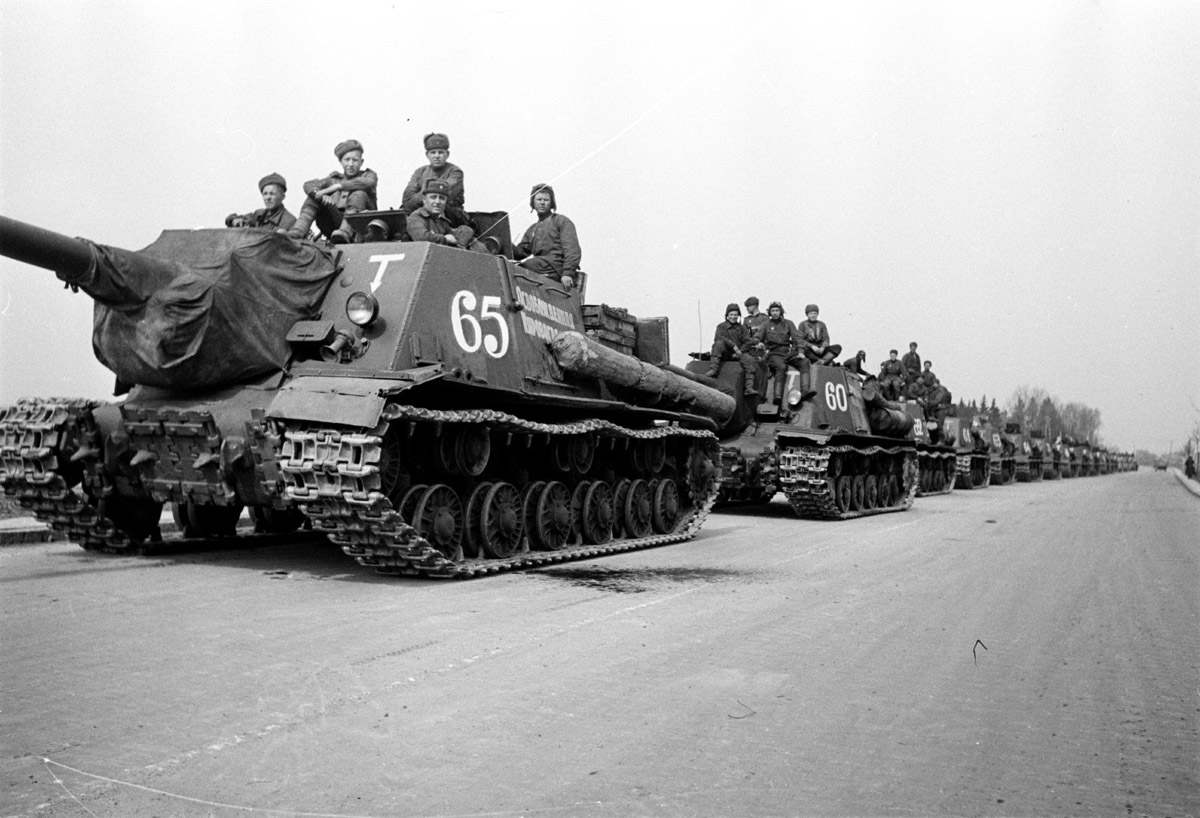
ISU-152 FORMATION
ISU-152 Armament
The main armament of the ISU-152 was a 152-mm howitzer-gun ML-20 S mod. 1937/43 (GRAU Index – 52-PS-544C). The gun was mounted in a frame on the frontal armor plate of the cabin and had vertical aiming angles from −3° to +20°, the horizontal aiming sector was 10°. The height of the line of fire was 1.8 m; direct shot range – 800-900 m at a target height of 2.5-3 m, direct fire range – 3800 m, maximum firing range – 6200 m. The shot was fired by means of an electric or manual mechanical descent.
The ammunition load of the gun was 21 shots of separate loading. The shells were laid along both sides of the cabin, the charges – in the same place, as well as on the bottom of the fighting compartment and on the rear wall of the cabin. Compared to the range of ammunition for the ML-20 towed guns, the ammunition load of the ISU-152 was significantly less diverse. It included:
- armor-piercing tracer sharp-headed projectile 53-BR-540 weighing 48.8 kg, muzzle velocity 600 m/s;
- high-explosive fragmentation cannon projectile 53-OF-540 weighing 43.56 kg, muzzle velocity 655 m/s at full charge.
Instead of armor-piercing tracer shells 53-BR-540, armor-piercing tracer blunt-headed shells with a ballistic tip 53-BR-540B (from the beginning of 1945) could be used.
For the destruction of reinforced concrete pillboxes concrete-piercing cannon projectile 53-G-545 could be introduced into the ammunition load. The range of propellant charges was also significantly reduced – it included a special charge 54-Zh-545B for an armor-piercing projectile and a full charge 54-ZhN-545 for a high-explosive fragmentation projectile. In principle, the ML-20S howitzer-cannon could fire all types of projectiles and charges from its towed version of the ML-20. However, in the manuals and firing tables for the ISU-152 during the Great Patriotic War, only the above ammunition appears. This does not exclude the possibility of firing other types of ammunition at that time, but there is no documentary evidence of such firing in the form of reports, instructions and regulatory documents of the time. This point is a still not fully explored issue and often becomes the cause of controversy in military-themed forums. On the other side,
From the beginning of 1945, the ISU-152 was equipped with a large-caliber anti-aircraft 12.7-mm DShK machine gun with an open or anti-aircraft sight K-8T on a turret on the right round hatch of the vehicle commander. Ammunition for the DShK was 250 rounds.
For self-defense, the crew had two submachine guns (submachine guns) PPSh or PPS with 1491 rounds of ammunition (21 disks) and 20 F-1 hand grenades.
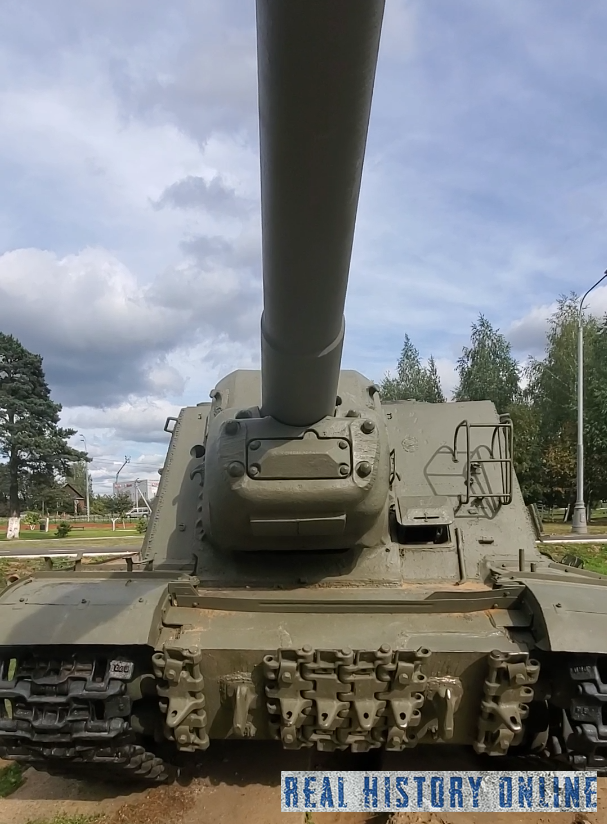
ISU 152 Cannon
ISU-152 AMMUNITION CHARACTERISTICS
| Ammunition nomenclature | |||||||
| Shot Index | Projectile index | Charge index | Projectile weight, kg | Mass of explosives, kg | Shot mass, kg | Muzzle velocity,
m/s |
Maximum firing range, km |
| Cumulative | |||||||
| 3VBP2 | 53-BP-540 | 4Ж6 | 27.67 | 5.6 | 41 | 680 | 3 |
| Armor-piercing | |||||||
| 53-VBR-545 | 53-BR-540 | 54-Zh-545B | 48.8 | 0.66 | 64 | 600 | 4 |
| 53-VBR-545B | 53-BR-540B | 54-Zh-545B | 46.5 | 0.48 | 64 | 600 | 4 |
| fragmentation | |||||||
| 53-VO-545A | 53-O-530A | 54-ZhN-545 | 40 | 5.31 | 56 | 670 | 11.8 |
| 53-VO-545AU | 53-O-530A | 54-ZhN-545U | 40 | 5.31 | 52 | 441 | 7.8 |
| High-explosive fragmentation | |||||||
| 53-VOF-545G | 53-OF-530 | 54-ZhN-545 | 40 | 5.83 | 56 | 670 | 11.8 |
| 53-VOF-545GU | 53-OF-530 | 54-ZhN-545U | 40 | 5.83 | 52 | 441 | 7.8 |
| 53-VOF-545 | 53-OF-540 | 54-ZhN-545 | 43.56 | 5.86 | 60 | 655 | 12.8 |
| 53-VOF-545U | 53-OF-540 | 54-ZhN-545U | 43.56 | 5.86 | 55 | 425 | 7.8 |
ISU-152 Engine
ISU-152 was equipped with a four-stroke V-shaped 12-cylinder diesel engine V-2- IS with a capacity of 520 liters. with. (382 kW ). The engine start was provided by an inertial starter with manual and electric drives or compressed air from two tanks in the fighting compartment of the vehicle. The electric drive of the inertial starter was an auxiliary electric motor with a power of 0.88 kW. The V-2IS diesel engine was equipped with a high-pressure fuel pump NK-1 with an all-mode regulator RNA-1 and a fuel supply corrector. To clean the air entering the engine, a Multicyclone type filter was used. Also, heating devices were installed in the engine compartment to facilitate starting the engine in the cold season. They could also be used to heat the fighting compartment of the vehicle. ISU-152 had three fuel tanks, two of which were located in the fighting compartment, and one in the engine compartment. The self-propelled gun was also equipped with four external additional fuel tanks that were not connected to the engine fuel system.
ISU-152 Transmission
The ISU-152 self-propelled guns were equipped with a mechanical transmission, which included:
- multi-disc main friction clutch of dry friction “steel according to Ferodo”;
- four- speed gearbox with demultiplier (8 gears forward and 2 reverse);
- two onboard two-stage planetary turning mechanisms with a steel-on-steel multi-plate dry friction locking clutch and band brakes ;
- two double-row combined final drives.
All transmission control drives are mechanical. Compared to the previous model of the SU-152 heavy self-propelled guns, planetary turning mechanisms were a new transmission element. The use of this unit made it possible to increase the overall reliability of the transmission as a whole, which was just the most significant drawback of the KV series tanks and vehicles based on it.
ISU-152 Chassis
ISU-152 at the Israeli Armored Forces Museum Yad la-Shiryon (Latrun ), rear right view. Clearly visible elements of the chassis of the machine
The suspension of the ISU-152 is individual torsion bar for each of the 6 solid-cast gable road wheels of small diameter on each side. Opposite each track roller, suspension balancers were welded to the armored hull. The drive wheels with removable lantern gears were located at the rear, and the sloths were identical to the road wheels. The upper branch of the caterpillar was supported by three small cast support rollers on each side; these rollers were borrowed from the design of the SU-152 self-propelled unit. Caterpillar tension mechanism – screw; each caterpillar consisted of 86 single-ridge tracks650 mm wide. The tracks could be distinguished by the presence of an egg-shaped relief hole in the middle of the crest of each track (these tracks were installed on military vehicles of later series, this type was also characteristic of the IS-3).
ISU-152 Electrical Equipment
The electrical wiring in the ISU-152 self-propelled guns was single-wire, the armored hull of the vehicle served as the second wire. The sources of electricity (operating voltages 12 and 24 V) were a P-4563A generator with a 1 kW RRA-24F relay-regulator and two 6-STE-128 batteries connected in series with a total capacity of 128 Ah. Electricity consumers included:
- external and internal lighting of the machine, illumination devices for sights and scales of measuring instruments;
- external sound signal and alarm circuit from the landing party to the crew of the vehicle;
- instrumentation (ammeter and voltmeter);
- howitzer-cannon electric trigger;
- means of communication – a radio station and a tank intercom;
- electrician of the motor group – electric motor of an inertial starter, spools of candles for winter starting the engine, etc.
Means of observation and sights
All hatches for entering and disembarking the crew, as well as the artillery panorama hatch, had Mk IV periscope instruments for monitoring the environment from inside the vehicle (3 in total). The driver in battle conducted observation through a viewing device with a triplex, which was protected by an armored flap. This viewing device was installed in an armored plug hatch on the front armor plate of the cabin to the left of the gun. In a calm environment, this plug hatch could be pushed forward, providing the driver with a more convenient direct view from his workplace.
For firing, the ISU-152 was equipped with two gun sights – a telescopic ST-10 for direct fire and a Hertz panorama for firing from closed positions. The ST-10 telescopic sight was calibrated for aimed fire at a distance of up to 900 m. However, the firing range of the ML-20S howitzer gun was up to 13 km, and for firing at a distance of more than 900 m (both direct fire and from closed positions) the gunner I had to use a second, panoramic sight. To provide a view through the upper left round hatch in the cabin roof, the panoramic sight was equipped with a special extension cord. To ensure the possibility of fire in the dark, the scales of the sights had illumination devices.
Means of communication
The means of communication included a 10R (or 10RK) radio station and a TPU-4-BisF intercom for 4 subscribers.
Radio stations 10R or 10RK were a set of transmitter, receiver and umformers (single-arm motor-generators ) for their power supply, connected to the on-board electrical network with a voltage of 24 V.
10P was a simplex tube heterodyne shortwave radio station operating in the frequency range from 3.75 to 6 MHz (wavelengths from 50 to 80 m). In the parking lot, the communication range in the telephone (voice) mode reached 20-25 km, while on the move it somewhat decreased. A longer communication range could be obtained in telegraph mode, when information was transmitted by telegraph key in Morse code or another discrete coding system. Frequency stabilization was carried out by a removable quartz resonator, there was no smooth frequency adjustment. 10P allowed communication on two fixed frequencies; to change them, another quartz resonator of 15 pairs was used in the radio set.
The 10RK radio station was a technological improvement of the previous 10R model, it became easier and cheaper to manufacture. This model has the ability to smoothly select the operating frequency, the number of quartz resonators has been reduced to 16. The characteristics of the communication range have not undergone significant changes.
The tank intercom TPU-4-BisF made it possible to negotiate between the crew members of the self-propelled guns even in a very noisy environment and connect a headset headset (head phones and throat phones ) to the radio station for external communication.
Serial and upgraded variants
Serial Variants
- ISU-152 based on the 1943 IS tank had a one-piece cast, monolithic frontal part of the hull;
- The ISU-152, based on the 1944 IS tank, had a frontal part of the hull welded from two rolled armor plates. This version of the self-propelled gun was distinguished by an increased thickness of the armored mask of the gun, from 60 to 90 mm, and more capacious fuel tanks.
From the beginning of 1945, the ISU-152 began to be equipped with a 12.7 mm DShK anti-aircraft machine gun. A number of previously produced vehicles also received this machine gun during repairs.
ISU-152 Upgrade options
The high combat and operational qualities of the ISU-152, as well as some stagnation in the development of Soviet barreled self-propelled artillery in the late 1950s (affecting the enthusiasm of the leadership of the army and the country for rocket technology) led to the decision to modernize the vehicles of this brand that remained in service. Modernization was carried out in two directions:
- ISU-152M (the prototype was designated Object 241M );
- ISU-152K (the prototype was designated Object 241K ).
The program of both post-war upgrades of the ISU-152 included:
- installation of a night vision device and an infrared searchlight;
- replacement of the V-2IS engine with the more modern V-54 ;
- increase in ammunition load from 20 to 30 shots;
- replacement of sights and telecommunications equipment (radio station and intercom) with more modern ones.
The upgraded vehicles were equipped with caterpillar fenders modeled on the IS-2M tank, additional fuel tanks and a log for self-pulling in the rear of the vehicle. Therefore, in their appearance, the modernized ISU-152M and ISU-152K differed markedly from the original version of the self-propelled gun.
ISU-152K differences:
- Instead of a fan system for blowing radiators, an ejection system was used.
- Another coolant heating system was installed.
- Changed radiators, fuel tanks, oil tank, individual elements of power plant systems.
- New air cleaners installed.
- The design of the roof of the power compartment, the cabin and partitions of the power compartment have been changed, changes have been made to the arrangement of the fender liner and wings.
- A new PS-10 sight was introduced instead of the ST-10, the design of the commander’s cupola was changed.
- Changes have been made to the mounting units of the gun, gun stoppers and sights (in particular, a ring around the sight on the gun mantlet has been added, it serves to protect against weather conditions and reduce glare from the sun).
- Increased ammo capacity and changed the placement of ammunition inside the BO.
- The placement of the anti-aircraft machine gun has been changed and an additional third hatch has been introduced on the cabin roof.
- Changes have been made to the design of the front gearbox.
- Automatic fire fighting equipment installed.
- Changes were made to the design of the bottom, aft additional armor was installed and the armor of the hatches serving the undercarriage (differed from the production series).
- Tracks from the T-10 were used, it was possible to install expansion plates in the holes in the track for movement on soft soils.
- New boxes were installed along the sides for transportable property (as a result of fastening spare parts and accessories were removed from the hull).
- New arrangement of fuel tanks in pairs on the modified stern.
- Both types of ISU were modernized, the early ones with a welded and rolled nose (the design of attachments is different).
- On some models, additional armor was installed on the top of the movable part of the armored mask (reinforced with 15 mm armor plate).
Vehicles based on the ISU-152
An ISU-based command vehicle at the Israeli Yad la-Shiryon Museum
After the end of the Great Patriotic War, the ISU-152 chassis (as well as the ISU-122 ) served as a base in the process of developing self-propelled artillery systems of high and special power, tactical missile launchers. The disarmed ISU-152 and ISU-122 with a welded gun embrasure in the front of the cabin, under the name ISU-T, were used as tank tractors, command vehicles, and mobile artillery observation posts. A number of such vehicles were transferred to civilian departments for use as tractors or transports in difficult terrain. On the railways of the USSR, a small number of disarmed ISU-152s were used, and are being used, in recovery trainsas tilters or tractors in emergency situations. There is even unconfirmed information about the presence of several such vehicles in the inventory fleet of Russian Railways.
On the same basis, tank tractors BTT-1 were built with enhanced functionality compared to ISU-T. Dampers were welded to the body of the BTT-1 for pushing an emergency tank with a log, the car was equipped with coulters at the rear, a platform above the engine compartment and a collapsible boom of a manual crane with a lifting capacity of up to three tons. Instead of a gun and ammunition, a powerful winch was placed in the wheelhouse, driven by a power take-off from the main engine of the vehicle. The BTT-1T variant was equipped with a set of rigging equipment instead of a winch. Also, on the basis of the ISU-152, experimental machines known as the ISU-152BM (high power) were created.
In Finland, on the basis of the captured ISU-152 (with tail number 1212), an BREM was created. Armament was dismantled from the car and towing equipment was installed.
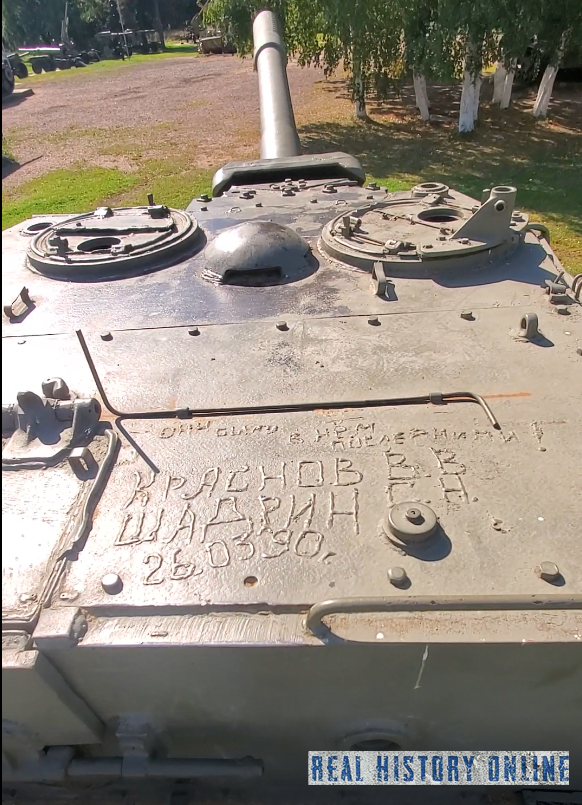
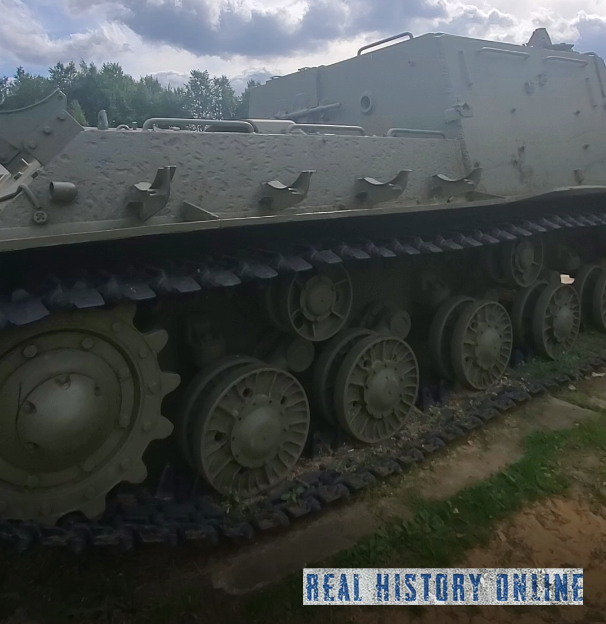
ISU-152




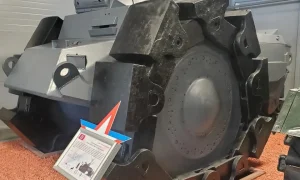

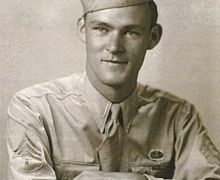


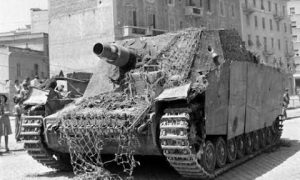


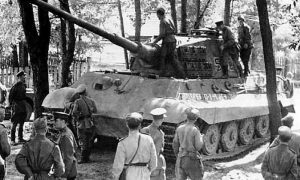

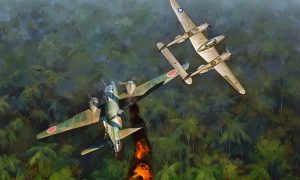







Admin
May 10, 2022 at 1:43 pm
TEST 1